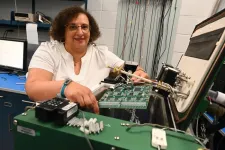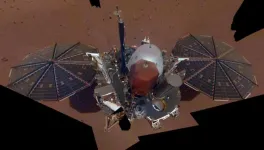(Press-News.org) Since the first demonstration of the laser in the 1960s, laser spectroscopy has become an essential tool for studying the detailed structures and dynamics of atoms and molecules. Advances in laser technology have further enhanced its capabilities. There are two main types of laser spectroscopy: frequency comb-based laser spectroscopy and tunable continuous-wave (CW) laser spectroscopy.
Comb-based laser spectroscopy enables extremely precise frequency measurements, with an accuracy of up to 18 digits. This remarkable precision led to a Nobel Prize in Physics in 2005 and has applications in optical clocks, gravity sensing, and the search for dark matter. Frequency combs also enable high-precision, high-speed broadband spectroscopy because they combine large bandwidth with high spectral resolution. However, one drawback is the low power per comb mode, which makes detecting trace gases difficult. The gaps between the comb modes also require additional techniques for measuring spectrally narrow features. In addition, high-precision measurements require comb sources with long-term coherence, which demands complex and sophisticated stabilization systems.
Tunable CW lasers offer high photon flux, long interaction paths, and frequency agility, making them ideal for sensitive molecular spectroscopy, gas sensing, and LIDAR applications with high signal-to-noise ratios (SNR). However, these systems often suffer from fluctuations in the laser frequency scan speed. Various methods, including interferometric approaches, single-sideband modulation, and optical frequency combs, have been developed to address these fluctuations. Frequency-comb-calibrated tunable laser spectroscopy combines the accuracy of a frequency comb with the tunability and high power of a CW laser. Nonetheless, this method requires a reference frequency comb with a flat optical spectrum and stable polarization over a wide range, which can be challenging to achieve.
Researchers at the Max Planck Institute for the Science of Light have developed a new, straightforward broadband spectroscopy method with Hz-level precision using a tunable laser. As reported in Advanced Photonics, this technique involves on-the-fly calibration of the laser frequency using a fiber cavity and a dual radio frequency (RF) modulation technique. This approach enables the precise tracking of the color of the sweeping laser at every point in time. It provides calibration markers, that serve as an easy-to-use optical frequency ruler in order to measure optical frequency distances between spectral features with ultra-high precision.
Using this method, the researchers measured minuscule deviations in the free spectral range of a fiber loop cavity over an 11-THz frequency range with sub-10-Hz precision, an order of magnitude improvement over existing tunable laser spectroscopy methods. The measurement speed was 1 THz/s, limited by the reference cavity's linewidth. Compared to frequency comb-based spectroscopy, this technique offers higher optical probe power and better spectral flatness and polarization stability.
The new method was also used to characterize spectral features of integrated photonic devices like microresonators and measuring the molecular absorption spectrum of HF gas with two orders of magnitude improvement in precision compared to existing methods. This robust and straightforward method does not require mode locking or phase locking, making it suitable for out-of-lab applications, including LIDAR systems, 3D imaging, open-path trace gas sensing, characterization of photonic devices, and calibration of astrophysical spectrometers. Its simplicity and robustness make it an excellent choice for use in challenging environments.
For details, see the original Gold Open Access article by Zhang, Bi, and Del’Haye, “On-the-fly precision spectroscopy with a dual-modulated tunable diode laser and Hz-level referencing to a cavity,” Adv. Photon. 6(4), 046003 (2024), doi 10.1117/1.AP.6.4.046003.
END
Tracking the color of light
Innovative diode laser spectroscopy enables precise tracking of the color of the sweeping laser at every point in time, setting new standards for frequency metrology and practical applications
2024-08-12
ELSE PRESS RELEASES FROM THIS DATE:
Common mechanisms underpinning neurodevelopmental disorders and psychiatric diseases
2024-08-12
Recent large-scale epidemiologic studies have increasingly suggested that aberrant brain development and psychiatric disorders may share common mechanisms. The interplay between genetic variants and environmental stress has been shown to significantly impact genome integrity, reshaping brain development. This can result in changes to neural networks, which are linked to neurodevelopmental and psychiatric disorders—areas where many questions remain unresolved.
For more information, visit: bit.ly/4ddJSV0
For contributing article to this research topic, visit: bit.ly/4crNG41
Please use the Hot-Topic Code: BMS-CMP-2024-HT-33 ...
Department of Energy announces 2024 Office of Science Distinguished Scientist Fellows and lecture series
2024-08-12
WASHINGTON, D.C. – Four of the nation’s top scientists have each been awarded $1 million in direct funding via the Department of Energy (DOE) Office of Science Distinguished Scientist Fellows program.
The program was established to develop, sustain, and promote scientific and academic excellence in Office of Science (SC) research through collaborations between universities and national laboratories.
The awards, authorized by the America COMPETES act, are bestowed on senior national laboratory scientists. The United States has ...
Mary Bishai named Distinguished Scientist Fellow
2024-08-12
UPTON, N.Y. — Physicist Mary Bishai of the U.S. Department of Energy’s (DOE) Brookhaven National Laboratory has been named a 2024 DOE Office of Science Distinguished Scientist Fellow. The honor recognizes her “enduring contributions at the intensity frontier of high energy physics in unraveling fundamental properties of neutrinos, extraordinary leadership and service to the particle physics community, and deep commitment to broadening participation through mentoring next generation scientists.”
As described in a DOE Office of Science press release issued today, the ...
Can meditation and stretching relieve cramping caused by cirrhosis?
2024-08-12
People suffering from cirrhosis may find some symptom relief from two accessible activities: stretching and meditation.
A study from the University of Michigan compared the two therapies as a means to relieve nocturnal muscle cramps and found both effective.
The resulting paper, “The RELAX randomized controlled trial: Stretching versus meditation for nocturnal muscle cramps,” appeared in Liver International.
The study
Two out of every three people with cirrhosis experience muscle cramps at night that wake them from sleep.
Since ...
Study reveals oleoyl-ACP-hydrolase underpins lethal respiratory viral disease
2024-08-12
Respiratory infections can be severe, even deadly, in some individuals, but not in others. Scientists at St. Jude Children’s Research Hospital, the Peter Doherty Institute for Infection and Immunity and other collaborators have gained new understanding of why this is the case by uncovering an early molecular driver that underpins fatal disease. Oleoyl-ACP-hydrolase (OLAH) is an enzyme involved in fatty acid metabolism. A study, published today in Cell, shows that OLAH drives severe disease outcomes.
The important role of OLAH in immune response has gone unrecognized for several reasons, including a lack of noticeable expression in healthy ...
Advances in drug delivery carrier microwave-assisted reactions for enhanced therapeutics and diagnostic purposes
2024-08-12
Microwave irradiation technology is emerging as a powerful tool in the fields of organic synthesis, pharmaceuticals, and nanocarrier development. Recently, microwave-assisted reactions have gained significant attention for their effectiveness in synthesizing drug delivery carriers. This technology offers notable advantages, including high yield, shorter reaction times, and improved compound purity, making it a promising approach for developing nanoparticles with enhanced physicochemical properties and bioavailability.
For more information, please visit: bit.ly/3SFk4cf
For contributing article in this research topic, visit: bit.ly/3WXyoza
Use ...
Presence of liquid water most probable explanation for data collected by mars lander
2024-08-12
Data about Mars’ planetary crust gathered from the Mars InSight lander are best explained by the conclusion that the crust has stores of liquid water.
Analysis led by Vashan Wright, a geophysicist at UC San Diego’s Scripps Institution of Oceanography, provides the best evidence to date that the planet still has liquid water in addition to that frozen at its poles. If that conclusion is true, it sets the stage for new research considering the planet’s habitability and continuing a search for life that exists on a place other than Earth. The potential presence of liquid water on Mars has tantalized scientists for decades. Water is essential for a habitable planet.
“Understanding ...
Scientists find oceans of water on Mars. It's just too deep to tap.
2024-08-12
Using seismic activity to probe the interior of Mars, geophysicists have found evidence for a large underground reservoir of liquid water — enough to fill oceans on the planet's surface.
The data from NASA's Insight lander allowed the scientists to estimate that the amount of groundwater could cover the entire planet to a depth of between 1 and 2 kilometers, or about a mile.
While that’s good news for those tracking the fate of water on the planet after its oceans disappeared more than 3 billion years ago, the reservoir won't be of much use to anyone trying to tap into it to supply a future Mars colony. It's ...
UMass Amherst researchers ID body’s ‘quality control’ regulator for protein folding
2024-08-12
AMHERST, Mass. – Anyone who’s tried to neatly gather a fitted sheet can tell you: folding is hard. Get it wrong with your laundry and the result can be a crumpled, wrinkled mess of fabric, but when folding fails among the approximately 7,000 proteins with an origami-like complexity that regulate essential cellular functions, the result can lead to one of a multitude of serious diseases ranging from emphysema and cystic fibrosis to Alzheimer’s disease. Fortunately, our bodies have a quality-control system ...
Forest restoration can boost people, nature and climate simultaneously
2024-08-12
Forest restoration can benefit humans, boost biodiversity and help tackle climate change simultaneously, new research suggests.
Restoring forests is often seen in terms of “trade-offs” – meaning it often focuses on a specific goal such as capturing carbon, nurturing nature or supporting human livelihoods.
The new study, by the universities of Exeter and Oxford, found that restoration plans aimed at a single goal tend not to deliver the others.
However, “integrated” plans would deliver over 80% of the benefits in all three areas at once.
It also found that ...
LAST 30 PRESS RELEASES:
58% of patients affected by 2022 mpox outbreak report lasting physical symptoms
Golden Gate method enables rapid, fully-synthetic engineering of therapeutically relevant bacteriophages
Polar weather on Jupiter and Saturn hints at the planets’ interior details
Socio-environmental movements: key global guardians of biodiversity amid rising violence
Global warming and CO2 emissions 56 million years ago resulted in massive forest fires and soil erosion
Hidden order in quantum chaos: the pseudogap
Exploring why adapting to the environment is more difficult as people age
Society for Laboratory Automation and Screening welcomes new scientific director: Madeline M. Farley, Ph.D.
Austrian cow shows first case of flexible, multi-purpose tool use in cattle
Human nasal passages defend against the common cold and help determine how sick we get
Research alert: Spreading drug costs over the year may ease financial burden for Medicare cancer patients
Hospital partnership improves follow up scans, decreases long term risk after aortic repair
Layered hydrogen silicane for safe, lightweight, and energy-efficient hydrogen carrier
Observing positronium beam as a quantum matter wave for the first time
IEEE study investigates the effects of pointing error on quantum key distribution systems
Analyzing submerged fault structures to predict future earthquakes in Türkiye
Quantum ‘alchemy’ made feasible with excitons
‘Revoice’ device gives stroke patients their voice back
USF-led study: AI helps reveal global surge in floating algae
New method predicts asthma attacks up to five years in advance
Researchers publish first ever structural engineering manual for bamboo
National poll: Less than half of parents say swearing is never OK for kids
Decades of suffering: Long-term mental health outcomes of Kurdish chemical gas attacks
Interactional dynamics of self-assessment and advice in peer reflection on microteaching
When aging affects the young: Revealing the weight of caregiving on teenagers
Can Canada’s health systems handle increased demand during FIFA World Cup?
Autistic and non-autistic faces may “speak a different language” when expressing emotion
No clear evidence that cannabis-based medicines relieve chronic nerve pain
Pioneering second-order nonlinear vibrational nanoscopy for interfacial molecular systems beyond the diffraction limit
Bottleneck in hydrogen distribution jeopardises billions in clean energy
[Press-News.org] Tracking the color of lightInnovative diode laser spectroscopy enables precise tracking of the color of the sweeping laser at every point in time, setting new standards for frequency metrology and practical applications





